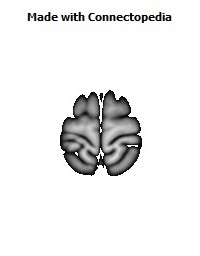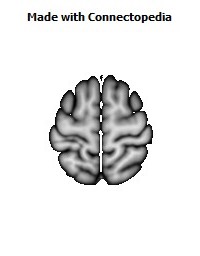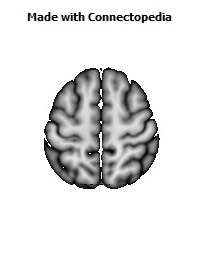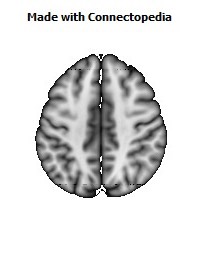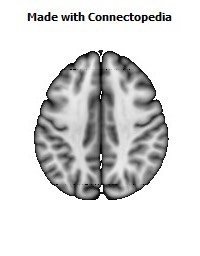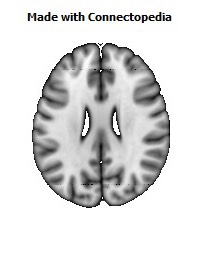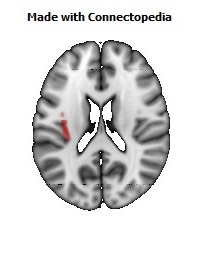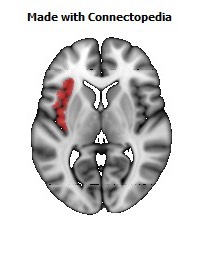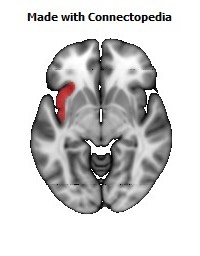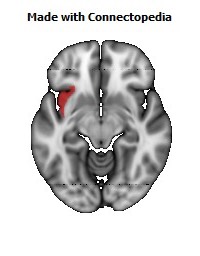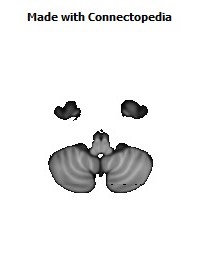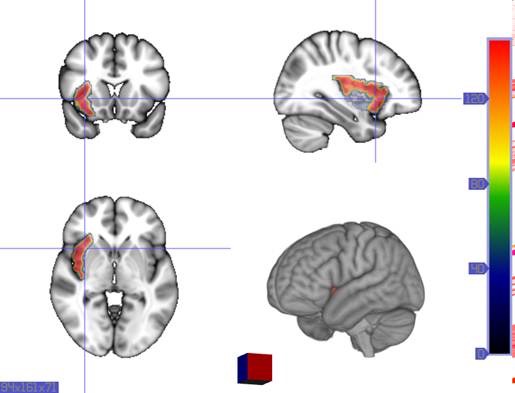
In each hemisphere of the mammalian brain the insular cortex (often called insula, insulary cortex or insular lobe) is a portion of the cerebral cortex folded deep within the lateral sulcus (the fissure separating the temporal lobe from the parietal and frontal lobes).
The insulae are believed to be involved in consciousness and play a role in diverse functions usually linked to emotion or the regulation of the body's homeostasis. These functions include perception, motor control, self-awareness, cognitive functioning, and interpersonal experience. In relation to these, it is involved in psychopathology.
The insular cortex is divided into two parts: the larger anterior insula and the smaller posterior insula in which more than a dozen field areas have been identified. The cortical area overlying the insula toward the lateral surface of the brain is the operculum (meaning lid). The opercula are formed from parts of the enclosing frontal, temporal, and parietal lobes.
Structure
Connections
The anterior part of the insula is subdivided by shallow sulci into three or four short gyri.
The anterior insula receives a direct projection from the basal part of the ventral medial nucleus of the thalamus and a particularly large input from the central nucleus of the amygdala. In addition, the anterior insula itself projects to the amygdala.
One study on rhesus monkeys revealed widespread reciprocal connections between the insular cortex and almost all subnuclei of the amygdaloid complex. The posterior insula projects predominantly to the dorsal aspect of the lateral and to the central amygdaloid nuclei. In contrast, the anterior insula projects to the anterior amygdaloid area as well as the medial, the cortical, the accessory basal magnocellular, the medial basal, and the lateral amygdaloid nuclei.
The posterior part of the insula is formed by a long gyrus.
The posterior insula connects reciprocally with the secondary somatosensory cortex and receives input from spinothalamically activated ventral posterior inferior thalamic nuclei. More recent work by Bud Craig and his colleagues has shown that this region receives inputs from the ventromedial nucleus (posterior part) of the thalamus that are highly specialized to convey homeostatic information such as pain, temperature, itch, local oxygen status, and sensual touch.
A human neuroimaging study using diffusion tensor imaging revealed that the anterior insula is interconnected to regions in the temporal and occipital lobe, opercular and orbitofrontal cortex, triangular and opercular parts of the inferior frontal gyrus. The same study revealed differences in the anatomical connection patterns between the left and right hemisphere.
The 'circular sulcus of insula' (or sulcus of Reil)is a semi-circular sulcus or fissure that separates the insula from the neighboring gyri of the operculum in the front, above, and behind.
Cytoarchitecture
The insular cortex has regions of variable cell structure or cytoarchitecture, changing from granular in the posterior portion to agranular in the anterior portion. The insula also receives differential cortical and thalamic input along its length.
Origins
The insular cortex is considered a separate lobe of the telencephalon by some authorities. Other sources see the insula as a part of the temporal lobe. It is also sometimes grouped with limbic structures deep in the brain into a limbic lobe.
As a paralimbic cortex, the insular cortex is considered to be a relatively old structure. It plays a role in a variety of highly conserved functions that are related to basic survival needs, such as taste, visceral sensation, and autonomic control (so-called homeostatic functions). There is evidence that, in addition to its more conserved functions, the insula may play a role in certain "higher" functions that operate only in humans and other great apes. John Allman and his colleagues have shown that the anterior insular cortex contains a population of neurons, called spindle neurons. These neurons are also found in the anterior cingulate cortex, which is another region that has reached a high level of specialization in great apes. Spindle neurons are found at a higher density in the right insular cortex. It has been speculated that these neurons are involved in cognitive-emotional processes that are specific to great apes, such as empathy and self-aware emotional feelings. This is supported by functional imaging results showing that the structure and function of the right anterior insula are correlated with the ability to feel one's own heartbeat, or to empathize with the pain of others. It is thought that these functions are not distinct from the "lower" functions of the insula but rather arise as a consequence of the role of the insula in conveying homeostatic information to consciousness.
Function
Interoceptive awareness
The right anterior insula aids interoceptive awareness of body states, such as the ability to time one's own heartbeat. Moreover, greater right anterior insular gray matter volume correlates with increased accuracy in this subjective sense of the inner body, and with negative emotional experience. It is also involved in the control of blood pressure, in particular during and after exercise, and its activity varies with the amount of effort a person believes he/she is exerting.
The insular cortex also is where the sensation of pain is judged as to its degree. Further, the insula is where a person imagines pain when looking at images of painful events while thinking about their happening to one's own body. Those with irritable bowel syndrome have abnormal processing of visceral pain in the insular cortex related to dysfunctional inhibition of pain within the brain.
Another perception of the right anterior insula is the degree of nonpainful warmth or nonpainful coldness of a skin sensation. Other internal sensations processed by the insula include stomach or gastric distension. A full bladder also activates the insular cortex.
One brain imaging study suggests that the unpleasantness of subjectively perceived dyspnea is processed in the right human anterior insula and amygdala.
The cerebral cortex processing vestibular sensations extends into the insula, with small lesions in the anterior insular cortex being able to cause loss of balance and vertigo.
Other noninteroceptive perceptions include passive listening to music, laughter, and crying, empathy and compassion, and language.
Motor control
In motor control, it contributes to hand-and-eye motor movement, swallowing, gastric motility, and speech articulation. It has been identified as a "central command” centre that ensures that heart rate and blood pressure increase at the onset of exercise. Research upon conversation links it to the capacity for long and complex spoken sentences. It is also involved in motor learning and has been identified as playing a role in the motor recovery from stroke.
Homeostasis
In homeostasis, it controls autonomic functions through the regulation of the sympathetic and parasympathetic systems. It has a role in regulating the immune system.
Self
It has been identified as playing a role in the experience of bodily self-awareness, sense of agency, and sense body ownership.
Social emotions
The anterior insula processes a person's sense of disgust both to smells and to the sight of contamination and mutilation — even when just imagining the experience. This associates with a mirror neuron-like link between external and internal experiences.
In social experience, it is involved in the processing of norm violations, emotional processing, empathy, and orgasms.
Emotions
The insular cortex, in particular its most anterior portion, is considered a limbic-related cortex. The insula has increasingly become the focus of attention for its role in body representation and subjective emotional experience. In particular, Antonio Damasio has proposed that this region plays a role in mapping visceral states that are associated with emotional experience, giving rise to conscious feelings. This is in essence a neurobiological formulation of the ideas of William James, who first proposed that subjective emotional experience (i.e., feelings) arise from our brain's interpretation of bodily states that are elicited by emotional events. This is an example of embodied cognition.
In terms of function, the insula is believed to process convergent information to produce an emotionally relevant context for sensory experience. To be specific, the anterior insula is related more to olfactory, gustatory, vicero-autonomic, and limbic function, whereas the posterior insula is related more to auditory-somesthetic-skeletomotor function. Functional imaging experiments have revealed that the insula has an important role in pain experience and the experience of a number of basic emotions, including anger, fear, disgust, happiness, and sadness.
The anterior insular cortex (AIC) is believed to be responsible for emotional feelings, including maternal and romantic love, anger, fear, sadness, happiness, sexual arousal, disgust, aversion, unfairness, inequity, indignation, uncertainty, disbelief, social exclusion, trust, empathy, sculptural beauty, a ‘state of union with God’, and hallucinogenic state.
Functional imaging studies have also implicated the insula in conscious desires, such as food craving and drug craving. What is common to all of these emotional states is that they each change the body in some way and are associated with highly salient subjective qualities. The insula is well-situated for the integration of information relating to bodily states into higher-order cognitive and emotional processes. The insula receives information from "homeostatic afferent" sensory pathways via the thalamus and sends output to a number of other limbic-related structures, such as the amygdala, the ventral striatum, and the orbitofrontal cortex, as well as to motor cortices.
A study using magnetic resonance imaging found that the right anterior insula is significantly thicker in people that meditate.
Another study using voxel-based morphometry and MRI on experienced Vipassana meditators was done to extend the findings of Lazar et al., which found increased grey matter concentrations in this and other areas of the brain in experienced meditators.
Salience
Functional imaging research suggests the insula is involved in two types of salience. Interoceptive information processing that links interoception with emotional salience to generate a subjective representation of the body. This involves, first, the anterior insular cortex with the pregenual anterior cingulate cortex (Brodmann area 33) and the anterior and posterior mid-cingulate cortices, and, second, a general salience system concerned with environmental monitoring, response selection, and skeletomotor body orientation that involves all of the insular cortex and the mid-cingulate cortex.
An alternative or perhaps complementary proposal is that the right anterior insular regulates the interaction between the salience of the selective attention created to achieve a task (the dorsal attention system) and the salience of arousal created to keep focused upon the relevant part of the environment (ventral attention system). This regulation of salience might be particularly important during challenging tasks where attention might fatigue and so cause careless mistakes but if there is too much arousal it risks creating poor performance by turning into anxiety.
Clinical significance
Progressive non-fluent aphasia
Progressive non-fluent aphasia is the deterioration of normal language function that causes individuals to lose the ability to communicate fluently while being still being able to comprehend single words and intact other non-linguistic cognition. It is found in a variety of degenerative neurological conditions including Pick's disease, motor neuron disease, corticobasal degeneration, frontotemporal dementia, and Alzheimer's disease. It is associated with hypometabolism and atrophy of the left anterior insular cortex.
Addiction
A number of functional brain imaging studies have shown that the insular cortex is activated when drug abusers are exposed to environmental cues that trigger cravings. This has been shown for a variety of drugs, including cocaine, alcohol, opiates, and nicotine. Despite these findings, the insula has been ignored within the drug addiction literature, perhaps because it is not known to be a direct target of the mesotelencephalic dopamine system, which is central to current dopamine reward theories of addiction. Research published in 2007 has shown that cigarette smokers suffering damage to the insular cortex, from a stroke for instance, have their addiction to cigarettes practically eliminated. These individuals were found to be up to 136 times more likely to undergo a disruption of smoking addiction than smokers with damage in other areas. Disruption of addiction was evidenced by self-reported behavior changes such as quitting smoking less than one day after the brain injury, quitting smoking with great ease, not smoking again after quitting, and having no urge to resume smoking since quitting. The study was conducted on average eight years after the strokes, which opens up the possibility that recall bias could have affected the results. More recent prospective studies, which overcome this limitation, have corroborated these findings. This suggests a significant role for the insular cortex in the neurological mechanisms underlying addiction to nicotine and other drugs, and would make this area of the brain a possible target for novel anti-addiction medication. In addition, this finding suggests that functions mediated by the insula, especially conscious feelings, may be particularly important for maintaining drug addiction, although this view is not represented in any modern research or reviews of the subject.
A recent study in rats by Contreras et al. corroborates these findings by showing that reversible inactivation of the insula disrupts amphetamine conditioned place preference, an animal model of cue-induced drug craving. In this study, insula inactivation also disrupted "malaise" responses to lithium chloride injection, suggesting that the representation of negative interoceptive states by the insula plays a role in addiction. However, in this same study, the conditioned place preference took place immediately after the injection of amphetamine, suggesting that it is the immediate, pleasurable interoceptive effects of amphetamine administration, rather than the delayed, aversive effects of amphetamine withdrawal that are represented within the insula.
A model proposed by Naqvi et al. (see above) is that the insula stores a representation of the pleasurable interoceptive effects of drug use (e.g., the airway sensory effects of nicotine, the cardiovascular effects of amphetamine), and that this representation is activated by exposure to cues that have previously been associated with drug use. A number of functional imaging studies have shown the insula to be activated during the administration of drugs of abuse. Several functional imaging studies have also shown that the insula is activated when drug users are exposed to drug cues, and that this activity is correlated with subjective urges. In the cue-exposure studies, insula activity is elicited when there is no actual change in the level of drug in the body. Therefore, rather than merely representing the interoceptive effects of drug use as it occurs, the insula may play a role in memory for the pleasurable interoceptive effects of past drug use, anticipation of these effects in the future, or both. Such a representation may give rise to conscious urges that feel as if they arise from within the body. This may make addicts feel as if their bodies need to use a drug, and may result in persons with lesions in the insula reporting that their bodies have forgotten the urge to use, according to this study.
Other clinical conditions
The insular cortex has been suggested to have a role in anxiety disorders, and emotion dysregulation.
History
The insula was first described by Johann Christian Reil while describing cranial and spinal nerves and plexi. Henry Gray in Gray's Anatomy is responsible for it being known as the Island of Reil.





